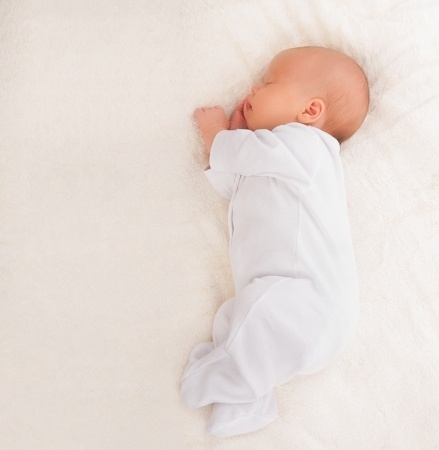

SIDS Rate Stagnates
The term SIDS sends shudders down the spines of most new parents and for many years, experts did not know what was causing SIDS or how to prevent it. Sudden Infant Death Syndrome is the name given to when a baby dies unexpectedly in his sleep. In 2010, 2,000 babies died of SIDS, according US government statistics. Today it is known that most babies who die of SIDS were actually in an unsafe sleep environment. Unsafe sleeping practices include a baby with his head facing down, the head covered by a blanket or pillow, or the head getting wedged between sofa cushions. In some cases, a co-sleeping parent rolls on top of the infant in the night. These scenarios are signs of accidental suffocation, not a mysterious death such as SIDS. Some in the medical community are questioning whether SIDS is really the right term to use anymore but believe it is still useful because of its recognition.
SIDS Risk Factors
SIDS is the leading cause of death among infants between one month and 12 months of age, although SIDS is most prevalent up until four months of age.
Approximately one in five infant SIDS deaths occur while the infant is being cared for by a non-parent. Many of the deaths happen when a baby who is used to sleeping on his back is placed on his tummy instead. Babies who are used to sleeping on their backs and are placed to sleep on their tummies are 18 times more likely to die from SIDS. Parents should make sleeping practices very clear to caregivers before leaving them in their care.
Infant Sleep Recommendations from The American Academy of Pediatrics
Safe Sleep Practices
- Always place your baby to sleep on his back.
- Don’t cover your baby’s head in a blanket or over bundle him in clothing or blankets.
- Check to make sure your baby isn’t getting too hot. Signs that your baby is overheated include sweating, damp hair, flushed cheeks, heat rash, and rapid breathing. Dress the baby lightly for sleep and set the room temperature at a comfortable temperature.
Safe Sleep Environment
- Your baby should sleep in a safety-approved crib, cradle or bassinet with a firm mattress and well fitting sheets.
- Don’t place babies to sleep on adult beds, chairs, sofas, waterbeds, or cushions.
- Avoid placing toys, stuffed animals or soft bedding including fluffy blankets, comforters, and pillows inside your baby’s sleeping space. These items can impair your infant from breathing if they end up covering their face.
- Your baby should sleep in your room for at least the first three months but preferably up to one year. Place the crib, cradle or bassinet within arm’s reach so you can easily breast-feed and comfort your baby.
- Do not smoke inside your home.
The “Back to Sleep” Campaign
The “Back to Sleep” public health campaign was launched in 1992 after public health officials became alarmed at the number of infants dying in their cribs. The campaign has proven very successful and as back-sleeping rates have soared, the SIDS rate has dropped. By 2000, the SIDS rate had fallen 50 percent. Since 2000, however, progress has stalled and about one quarter of American parents say that they do not put their babies to sleep on their backs.
If you or a loved one were injured in an accident, you have enough to deal with. Let an experienced accident attorney fight for the full compensation that you deserve. It is not uncommon to receive a settlement from the insurance company that is five to ten times bigger with the help of a lawyer. Call the caring accident attorneys at Tario & Associates, P.S. in Bellingham, WA today for a FREE consultation! We have been representing residents of Whatcom County, Skagit County, Island County and Snohomish County since 1979. You will pay nothing up front and no attorney fees at all unless we recover damages for you!




